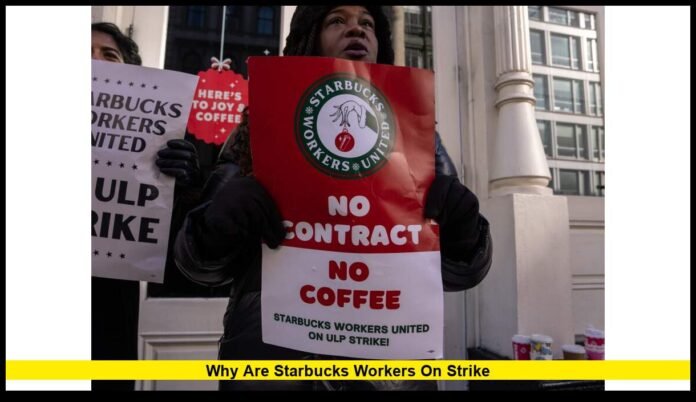The question why are Starbucks workers on strike has gained national attention as thousands of baristas across the United States continue an open-ended labor action. As of November 13, 2025, unionized Starbucks workers have staged walkouts in dozens of cities, escalating their campaign for a first labor contract and spotlighting growing tensions around pay, staffing, scheduling, and alleged unfair labor practices. The strike marks one of the most visible labor actions in the company’s history.
Latest Developments
A wave of coordinated walkouts began early Thursday morning during Starbucks’ annual Red Cup Day, one of the busiest sales events of the year. More than a thousand unionized workers participated across roughly 65 stores in over 40 cities. This strike is open-ended, meaning workers have not set an end date and say the action will continue until meaningful progress occurs at the bargaining table.
Starbucks maintains that fewer than 1% of its U.S. stores were affected. The union, however, argues that the walkout is a strategic demonstration meant to draw national attention to ongoing contract delays and what workers describe as persistent job-quality problems.
Why Workers Launched the Strike
1. Stalled Contract Negotiations
Unionized baristas have been attempting to secure a first contract since early 2024. After months of bargaining, talks stalled when workers rejected a proposal they said failed to address core issues such as predictable schedules, adequate staffing, and wage progression.
Union representatives say discussions fell apart because the company did not offer enforceable standards that would materially improve working conditions. Starbucks asserts that it has participated in numerous bargaining sessions and remains willing to negotiate, but that union leaders walked away from talks.
2. Pay and Hours Concerns
Workers have voiced frustration over inconsistent hours that they say undercut their actual earnings. Though Starbucks advertises strong pay and benefits, many baristas report being scheduled for fewer than 20 hours per week, making it harder to qualify for key benefits or take home wages that match cost-of-living demands in major cities.
Baristas also cite rising rent, transportation costs, and inflation as reasons they are pushing for higher guaranteed hours and clearer wage progression.
3. Staffing and Scheduling Problems
Employees argue that stores are frequently understaffed, especially during high-volume promotional days. They say this leads to long customer lines, overwhelming workloads, and increased stress behind the bar. Workers want the company to implement enforceable staffing guidelines and more transparent scheduling rules.
Starbucks counters that the majority of workers receive their preferred hours, but baristas say that chronic short-staffing undermines the workplace experience and compromises service quality.
4. Allegations of Unfair Labor Practices
Workers have also tied the strike to what they describe as widespread unfair labor practices. Hundreds of complaints have been filed nationally, with allegations that pro-union employees were disciplined or terminated, and that operational changes were implemented without bargaining.
Starbucks denies these claims and says it has not engaged in anti-union behavior. The company maintains that store-level decisions and policy adjustments are part of regular operations, not retaliation.
How the Strike Unfolded
Workers strategically timed the strike to coincide with Red Cup Day, when stores see some of their highest annual traffic. By walking out during a major promotional event, employees aimed to highlight their role in the company’s success while increasing pressure for contract progress.
Participating stores posted signs, picketed sidewalks, and urged customers to express support by not entering struck locations. Many non-union customers encountered delays or temporary closures at affected stores.
Though only a fraction of Starbucks’ U.S. locations are unionized, the visibility of the Red Cup Day strike amplified national attention and created heavy social-media momentum.
Why the Strike Carries National Significance
This labor action is about more than workplace grievances. It represents a pivotal moment in the modern labor movement. Starbucks is one of the largest and most recognizable brands in the country, and its workers have become a symbol of organizing in the food-service and retail sectors.
Key reasons the strike matters:
- It may shape future organizing at major chains. A successful contract could ignite new union activity nationwide.
- It tests corporate responses to union drives. Starbucks’ approach may influence other companies’ strategies.
- It highlights broader U.S. conversations about living wages, scheduling stability, and workers’ rights.
- It’s happening during a peak retail season, magnifying potential impact on sales and public perception.
What Starbucks Says
Starbucks emphasizes that the striking stores represent a small share of its nationwide footprint. The company points to competitive pay, benefits, and career-development opportunities as evidence of its commitment to workers.
Executives say the company will continue operating normally during the strike and that they remain open to negotiations. They also stress ongoing operational improvements intended to strengthen customer experience and store-level efficiency.
What Comes Next
The open-ended nature of the strike means the situation could escalate if contract talks remain stalled. Workers warn that more stores may join in the coming days, especially as holiday promotions ramp up.
Labor analysts say the path forward depends on whether both parties return to productive negotiations. A contract breakthrough could ease tensions and stabilize operations, while continued stalemates may result in prolonged strikes, increased public pressure, and potential operational challenges during the holiday rush.
Either way, the question dominating headlines—why are Starbucks workers on strike—is set to remain at the center of national labor discussions.
Share your thoughts below and stay tuned as this story continues to unfold.
